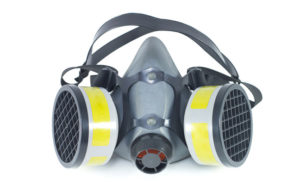Editor’s Note: We first published this piece in January 2016, but on April 7, 2020, reached out to Linda to ensure the information it contained was still pertinent in today’s climate. She confirmed that this information is up-to-date.
The U.S. Occupational Safety & Health Administration’s (OSHA’s) respiratory protection standard CFR 29 1910.134 was the fourth most frequently cited rule in fiscal year 2014. That ranking reflects the importance of respirators among the types of personal protective equipment (PPE) for workers who must perform tasks in hazardous environments.
It’s not enough for pest management firms to simply supply their workers with respirators. As the standard states, “In any workplace where respirators are necessary to protect the health of the employee or whenever respirators are required by the employer, the employer shall establish and implement a written respiratory protection program with worksite-specific procedures. The program shall be updated as necessary to reflect those changes in workplace conditions that affect respirator use.”
Respiratory protection can be complex, but pest management company owners and safety managers can create an effective respiratory protection program that is compliant with OSHA standards in five basic steps:
1. Develop a written respiratory protection program.
Include worksite-specific procedures when respirators are necessary or required by your company (rodent cleanout accounts, for example), and update the program as necessary to reflect changes in the workplace conditions that affect respirator use. Appoint a program administrator at your company who is qualified by appropriate training or experience to oversee the program. Review the program on an annual basis.
2. Perform medical evaluations.
As an employer, you’re required to identify a physician or other licensed health care provider (PLHCP) to provide an initial medical evaluation to determine each employee’s ability to use a respirator, before fit testing and use of respirator, and thereafter any time there is a change in the employee’s health or as indicated by the PLHCP.
3. Perform annual respirator fit testing, based on the type of respiratory protection the employee is using.
All respirators must be certified by the National Institute for Occupational Safety and Health (NIOSH), and be selected to protect against the specific hazards of the work environment. Various sizes, makes and models must be available to ensure all employees have respirators that fit properly.
4. Conduct respirator training annually with employees.
The training must include proper respirator selection, use and limitations based on their exposures, how to put on and remove (“donning and doffing”), how to check for defects, proper storage and maintenance, and how to perform a user seal check.
5. Stay current with all proper documentation.
Keeping written records of your employees’ respirator training and use progress all year is not only a good business practice and OSHA standard. It will also make your annual re-evaluation of your program that much easier to do.
Respirator fit testing
If the respirator doesn’t fit properly, it’s unlikely the user will be protected. Therefore, OSHA requires annual fit testing be performed. To test for the proper fit of a tight-fitting, negative-pressure respirator, either a qualitative or quantitative fit test can be performed:
- Qualitative is performed with an aerosolized testing agent such as Saccharin or Bitrex. The user must identify the taste prior to putting on the respirator, but not while wearing the respirator.
- Quantitative fit testing is performed using a machine that detects air leakage around the respirator seal.
OSHA protocol requires all employees be clean-shaven prior to fit testing, and anytime they are wearing their respirators. If performing qualitative fit testing using the saccharin or Bitrex method, the employee should not eat, drink or smoke at least 30 minutes prior to testing. When fit testing, the following protocol should be followed while wearing the respirator:
Fit test exercises
A passing fit test would require all items be checked. (Source: National Fit Testing Service)
- Normal breathing (1 min.)
- Deep breathing (1 min.)
- Turning head (1 min.)
- Nodding head (1 min.)
- Talking/Rainbow passage (1 min.)
- Bending/Jogging in place (1 min.)
- Grimace (1 min., quantitative only)
- Normal breathing (1 min.)
Read more COVID-19 coverage here: MyPMP.net/COVID-19
LANE, a Registered Respiratory Therapist, is president of National Fit Testing Service, Sarasota, Fla. Contact her at linda@nationalfittestservices.com.
The post 5 steps for respirator safety appeared first on Pest Management Professional.
from Pest Management Professional https://www.mypmp.net/2020/04/07/5-steps-for-respirator-safety/
Sacramento CA

No comments:
Post a Comment